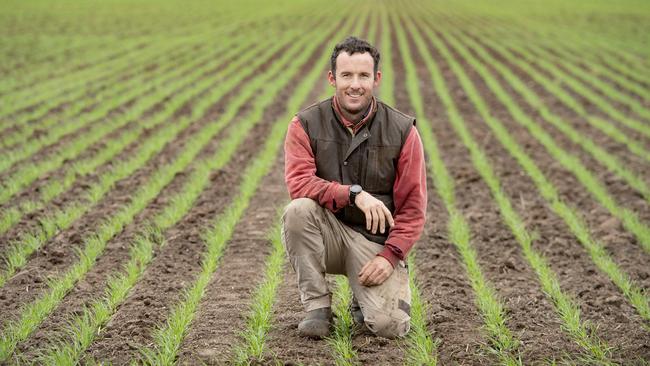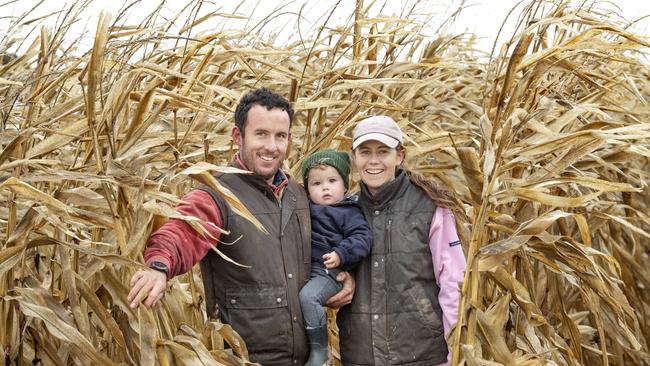Meet the Riverina family committed to continuous cropping
Across 1600ha in the southern NSW Riverina this family are generating cash flow with a mix of summer and winter crops.
Adding summer crops to the mix in the southern Riverina is set to diversify a family farm further and add greater growing capacity.
Cameron Sandral, who returned to the farm in 2019 after working as a builder, plans to push the bottom line in terms of production.
He farms with his mum Pam, partner Bridget, and son Harvey, 18 months, and aims to continuously crop the property, having recently added maize to the program as a summer option. There has also been an emphasis on seeding rates to drive yields higher in the winter program.
Cameron, Pam, and a farm worker run 1600ha of cropping country at Savernake in southern NSW and grow a mix of both irrigated and dryland crops.
It is an exclusively cropping operation and there is a blend of 40 per cent owned country and 60 per cent leased to generate economies of scale.
The property receives an average annual rainfall of 470mm, and it has access to water through the West Corurgan Private Irrigation system.
Cameron said corn was being grown this year as a summer crop for the first time. However, he had previously grown rice in 2019, but it wasn’t part of the program this year.
“The aim is to double crop and have summer crop as well (as winter crop) to generate cash flow,” Cameron said.
The Sandrals grow irrigated and dryland wheat, barley and canola. However, most of the operation is dryland.
A total of 130ha of corn was included, and 50ha of the crop is yet to be harvested. Cameron said he won’t put another crop of corn in directly after this one, however, it is certainly the plan to double crop.

ROTATIONAL OPPORTUNITY
Wheat accounts for the lion’s share of the cropping program and makes up about 50 per cent or more in area planted.
Now that summer cropping is incorporated too, a typical rotation is canola, corn, then corn again, and then back to canola.
This year, the winter crops were sown dry and planting started on April 10 and finished on May 10.
“The crops have emerged well, but some of the canola is quite slow,” Cameron said.
About 15mm of rain arrived in mid-May and the falls have been variable and certainly not plentiful. Cameron said there were instances of receiving up to 70mm in 24 hours, yet another farm just seven kilometres away recorded only 15mm in the same rainfall event.
Cameron said the farming country had red and grey soil types, and although it was reasonably flat, the drainage was good, and water ran off well and the soil pH ranged from 5 to 5.5.

DRIVING YIELDS
Since 2019, the winter cropping operation has been configured on a 12-inch controlled-traffic system.
The summer program uses a 30-inch row spacing for the maize and contractors are used to plant and harvest the crop.
The overall aim is to push yields hard and irrigated wheat has been known to yield around 7 tonnes/ha to 8 tonnes/ha.
“Last year, I had a paddock hit 7 tonnes/ha, and it had been wheat on wheat and was irrigated,” Cameron said.
In contrast the dryland wheat typically yields about 4 tonnes/ha.
Dryland barley can yield up to 5 tonnes/ha, and the aim for canola is 2.5 tonnes/ha when it is not irrigated.
“We can have hot spring times here and that can put pressure on canola at flowering,” he said. In the past, late frosts have also impacted overall yield potential.
It is early days for testing the yield ability of maize with the first crop not yet harvested.
Meanwhile, a sowing rate of 120kg/ha is being used for irrigated wheat to develop yield potential.
“This is the first year of trying that rate,” Cameron said.
It is a boost from the regular seeding of 90kg/kg to 100kg/ha that would traditionally be used on the property.
Dryland wheat has a seeding rate of 75kg/ha to 80kg/ha. The seeding rates are complemented by the use of mono-ammonium phosphate, which has been applied at 120kg/ha for the area on irrigation.
“It’s a case of hoping that everything adds up and then seeing what the paddocks can do,” he said.
MEETING THE MARKET
Marketing is done year-round, and some of the crop is sold directly at harvest, with the option to store it on the farm, too.
Cameron said he had recently installed a new silo to boost on-farm storage capacity. He uses silo bags as well and a lot of the grain is sold to feedlots.
He liaises with grain brokers and follows the market to determine the best course of action for marketing.
“All of the canola goes into town (Oaklands) and is sold directly from the header; the barley is stored on the farm,” he said.
Harvesting the winter crop starts with windrowing during the first weekend in November and the canola is harvested 10 days after that.
The aim is to have all of the winter crop harvested before Christmas.
“It has been tricky. Last year, we harvested before Christmas,” Cameron said.
However, the year before, there was still harvest dragging into February.

FUTURE OPTIONS OPEN
After the corn is harvested Cameron will reassess and consider if there is enough biomass to go forward with other summer cropping options such as adding faba beans to the mix.
The strategy has been to stay flexible. For instance less canola was planted this year due to the drier soil moisture profile at planting.
“We just didn’t have the full profile and we had to work with that,” Cameron said.
There is around 380ha of canola in the rotation, but in previous years, that amount has been doubled. It is a case of working with the seasonal conditions and markets and gauging the best options.
He said the challenges to farming continue to be input prices and while urea values have settled compared to what they were he remembers prices spiking above $1000 a tonne. And then last year, it was in short supply and hard to source.
“Farmers have to be prepared to carry inputs on farm and plan ahead,” he said.
In terms of farming, Cameron said he enjoys agriculture and being outside.
He said watching a crop grow and testing the production parameters through different management strategies was satisfying.
“It’s a challenge and one I enjoy,” he said.
In addition to farming, Cameron is also involved in the local community and plays footy for the Billabong Crows.
“It is a good community, and there are a lot of farmers here,” he said.




